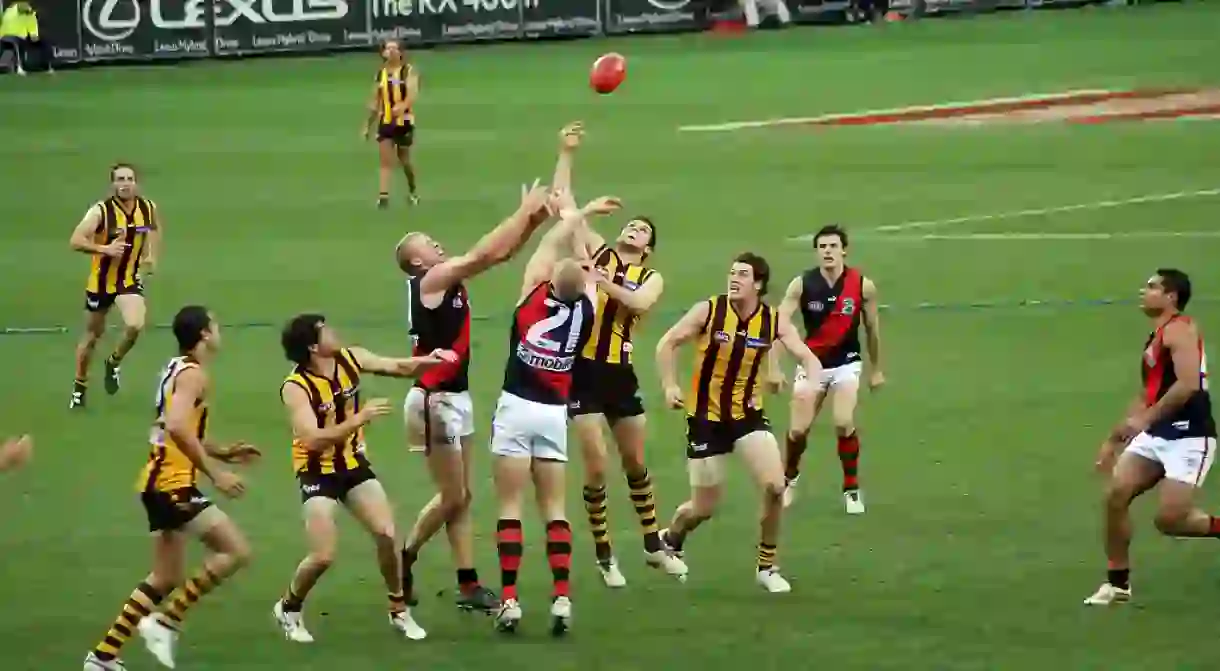8 Places to Catch an Australian Football Match

Imagine a sport that combines the physicality of rugby with the skill of football, the athleticism of gymnastics and the stamina of marathon running, plus a dash of Quidditch’s craziness thrown in for good measure. That sport exists, and it’s called Australian rules football. Want to catch a professional game Down Under? Get your hands on a ticket to one of these eight iconic stadiums.
Melbourne Cricket Ground
Cathedral, Memorial, Stadium

You know a venue is seriously iconic when it can be identified by one solitary letter: “the G”, Australia’s grandest sporting cathedral, where 100,000 devotees routinely come to worship the footballing gods. There’s nothing particularly charming about the G — it’s basically a symmetrical concrete bowl, split into three levels — but its sheer scale is mesmerising. The six-figure capacity makes it the largest stadium in the Southern Hemisphere, and one of the biggest in the world, swamping the Nou Camp in Barcelona (99,354), the Los Angeles Memorial Coliseum (93,607) and London’s Wembley (90,000).
Sydney Cricket Ground
Stadium, Architectural Landmark

What the 49,700-seat SCG might lack in size compared to the MCG, it more than makes up for in charm. The elegant 19th century pavilions provide a unique backdrop for Aussie rules football. Rival fans will be quick to tell you Sydney Swans supporters were born with a silver spoon in their mouth and a prawn sandwich on their plate — and they’d run away faster than Usain Bolt the moment the club hits hard times — but hey, the Swans have made 19 of the last 22 semi-finals series, so the bandwagon’s in full swing.
Adelaide Oval
Sports Center, Stadium

This genteel old cricket ground used to be a quaint little venue ringed with trees and red-roofed pavilions and a vintage scoreboard that displayed the score on hand-painted signs. That all changed in 2014 with a facelift of Michael Jackson proportions which added a couple of monstrous new grandstands but retained the old scoreboard and other details. The redevelopment brought Adelaide’s two Australian Football League (AFL) teams — the Crows and the Power — back from the maligned Football Park on the outskirts of town to a cutting-edge stadium in the heart of the city.
Perth Stadium
Park, Stadium
This stadium’s so new, it doesn’t even have a name yet. Fans of the West Coast Eagles and Fremantle Dockers — arguably the most parochial AFL supporters in the country — battled through the dilapidated Subiaco Oval for a couple of decades too long but now have a brand spanking new 60,000 seater in Perth to look forward to for the opening round of the 2018 season.
Etihad Stadium
Stadium
Any footy fan who’s shivered through four quarters at the MCG on a bitingly cold winter’s day knows that the Etihad roof is a godsend, shielding spectators from the bleak Melbourne winter. Built in 2000, the Docklands venue holds 56,347 spectators — a boutique compared to its hulking Melbourne neighbour but rocking when you get a full house echoing under the roof.
The Gabba
Stadium

Why does this stadium have a name that reminds you of hardcore techno music? Thanks to the great Australian tradition of abbreviating everything that can possibly be abbreviated. The Brisbane venue is located in the suburb of Woolloongabba — you do the math. The Gabba is home to the Brisbane Lions, the kings of the AFL jungle in the early 2000s, when they won three premierships on the trot between 2001 and 2003, before falling on harder times more recently.
Simonds Stadium
Stadium, Sports Center
While the nine other Victorian teams share the MCG and Etihad, travelling an hour down the road to Geelong is kind of like venturing beyond the Wall in Game of Thrones — cold and miserable. Plus, if you’re lucky enough to return, it’ll only be with your tail between your legs. That reputation as a place where opposition players (and fans) fear to tread is cemented by the Geelong Cats’ fearsome record on their home turf — they’ve only lost nine games at Simonds Stadium since 2006.
Blundstone Arena
Grass hills used to be a dime a dozen at old suburban footy grounds, but they’re a dying breed in this era of concrete mega-stadiums. That’s what makes the North Melbourne Kangaroos’ couple of ‘home’ games at Hobart’s Blundstone Arena each year so special, when the hill is covered with fans rugged up in their duffle coats and team colour scarves to protect themselves from the Antarctic breeze.













